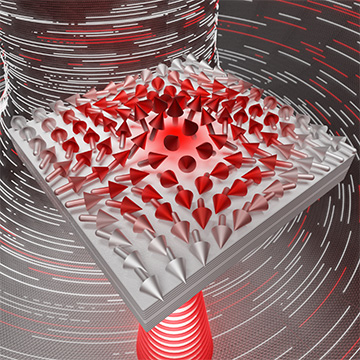
Spin texture of a second-order half-skyrmion (meron) on the surface of a birefringent cavity. [Image: Physics UW, M. Krol]
Particle-like vortices known as skyrmions have to date been observed in a variety of physical systems, including ferromagnets and light fields. Through suitable manipulation they might in future be used to make ultra-compact computer memory or enable extremely high-bandwidth telecommunications.
Another step forward in that direction has now been taken by researchers in Europe, who have used an optical microcavity to generate photonic fields that resemble half-skyrmions, or “merons.” They have shown in particular that it is possible to make stable second-order optical merons at room temperature (Optica, doi: 10.1364/OPTICA.414891).
Skyrmion stability
Skyrmions were first put forward in the 1950s by British physicist Tony Skyrme as a way of explaining how nucleons could emerge from the strong nuclear force field. They are regions of the field within which all field vectors either emerge from or converge onto a single point, possessing the striking property of topological stability.
This stability has made skyrmions the object of fairly intense study in solid-state physics. Several groups have shown it is possible to make skyrmions via the arrangement of magnetic spins within thin layers of ferromagnets. With these regions potentially measuring just a few nanometers across, skyrmion-based memory might in future be much smaller and also more energy-efficient than today’s magnetic storage devices.
Skyrmions have also been seen in a number of other physical settings, including Bose-Einstein condensates, surface plasmons and quantum Hall systems. In particular, Pavlos Lagoudakis and Helgi Sigurdsson of the University of Southampton in the U.K. and colleagues in 2016 reported having used polarized light to observe merons in semiconductor microcavities. A meron has half the topological charge of a skyrmion.
A new kind of meron
Lagoudakis and Sigurdsson have now joined forces with Jacek Szczytko and colleagues at the University of Warsaw in Poland to produce a new type of meron. They have observed polarizations in an electromagnetic field that can be regarded as second-order merons, which have double the vorticity of those seen five years ago—in other words, each meron is like a double-headed vortex.
They did so using a 2-micrometer-thick cavity containing a layer of liquid crystal placed between two Bragg reflectors. The liquid crystal had two refractive indices—one parallel to the long axis of its molecules and the other perpendicular. They were able to rotate this axis by applying a voltage to electrodes at either end of the cavity.
The idea was to change the relative refractive index of incoming light linearly polarized in the two orthogonal axes within the plane of the electrodes. Doing so, they concentrated on two configurations in particular—one in which the light along both axes had the same mode number and another in which the mode difference was equal to two. They then recorded the polarization of the outgoing light using a polarization-resolved imaging system.
Spin-to-orbital angular momentum
The first configuration, causing linearly-polarized cavity modes to split in energy, produced light with a polarization analogous to a second-order meron. The second configuration, which mixed photons of different longitudinal quantum numbers, instead yielded a second-order antimeron in the transmitted cavity light.
The U.K.–Polish collaboration says it has “provided the first experimental observation of a second-order meron and antimeron in an electromagnetic field.” The researchers argue that such a light-based set-up could provide condensed-matter physicists with a proxy for magnetic systems, potentially allowing them a relatively straightforward way of studying how second-order merons imprinted onto optically nonlinear media might attract, repel and annihilate one another.
When it comes to practical applications, the researchers reckon that in addition to very dense memory devices these cavity-derived optical merons might also lead to new types of communication and imaging. As they explain, their observations can be interpreted in terms of angular momentum being converted from the spin to orbital varieties. This, they say, provides a possible route for encoding data in the different degrees of twistedness of a light beam possessing orbital angular momentum.
